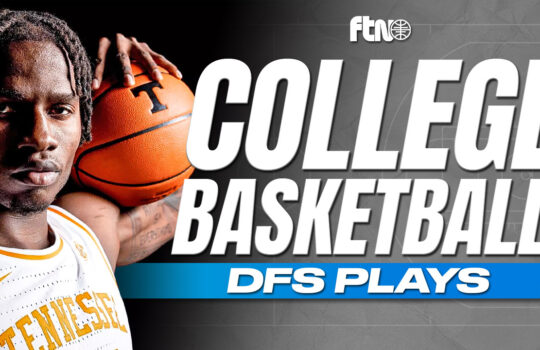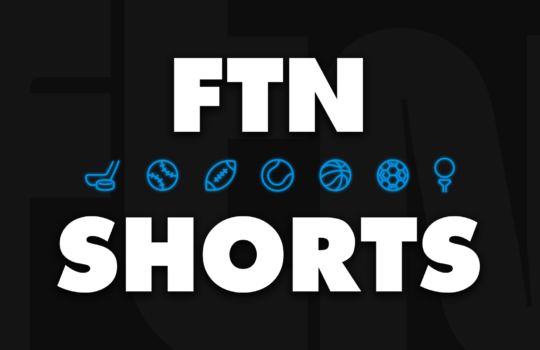
A year ago at this time, if you knew that Jamaal Williams would end the season with 17 rushing touchdowns, or even 28 inside-the-5 carries (8 more than any other player, 12 more than any other running back), you would have known a lot about the season. Yes, you’d have known Williams would be a good fantasy football value. But it would have told you a lot of other things:
- Maybe be a little skeptical of D’Andre Swift (he wasn’t getting the valuable goal-line work)
- Maybe be a little higher on the Lions’ receiving weapons (they were in close a lot, so even if Williams was getting the touchdowns, someone was getting them close)
- Maybe be a little higher on Jared Goff (same as the receiving weapons)
Well, D’Andre Swift was drafted as RB9 and finished RB21. Amon-Ra St. Brown was drafted as WR21 but finished WR7. T.J. Hockenson was traded, but the Lions’ TE group on the whole was ninth in scoring. And Jared Goff went from QB27 in ADP to QB10 in fantasy points.
There are certain instructive numbers every season. And while we don’t have a crystal ball, today I’ll look at the numbers that, if I knew them right now, would tell me the most for the 2023 fantasy football season.
(No, not just “How many fantasy points will X guy score?” That’s the “wish for more wishes” of this exercise, and that’s cheating. Don’t cheat.)
These are the numbers I wish I knew for 2023:
Deshaun Watson’s Passer Rating
During his Houston tenure, Deshaun Watson’s worst passer rating was 98.0, in 2019, when he averaged only 256.8 passer yards a game and had a career-high 12 interceptions. But in his six-game end-of-season stint as the Browns starter last year, that passer rating was 79.1, the INT rate was a half-percent higher than in 2019, the TD rate was a career low and his and every last indicator was horrific. Of course, it was also the first time we had seen him on the field in almost two years. So were the struggles an indicator of rust and a new team, or is Watson not the quarterback we used to know?
What It Would Tell Us
If Watson’s passer rating doesn’t bounce back up, all this optimism surrounding Amari Cooper, Elijah Moore and David Njoku (in some order) might be extremely misplaced. Per the FTN Fantasy splits tool, check out Cooper’s statlines with Watson last year compared to how he fared with Jacoby Brissett as the starter:
With Brissett, Cooper’s PPG made for borderline WR1 numbers; with Watson, he was more like a tail-end WR3. That’s the sort of season we’re in for without a Watson rebound, and Moore and Njoku, even worse. But if Watson is his vintage self, well, we could have three fantasy starters among the Cleveland pass-catchers, and wouldn’t that be fun.
Aaron Rodgers’ INT Rate
From 2018 to 2021, Aaron Rodgers threw 15 interceptions on 2,223 attempts, an absolutely unfathomable 0.7% interception rate. He led the league in that number all four years and never topped 1.0%. And then in 2022, he had 12 interceptions on 542 attempts, a 2.2% rate that was far off Dak Prescott’s league-leading (min. 150 attempts) 3.8% but still was a far cry from Rodgers’ norm. If we can chalk that up to Rodgers’ hand injury, the Packers’ O-line woes and/or a diminished receiver room, then maybe it can come back down. But that INT rate certainly was the canary in the coal mine.
What It Would Tell Us
If I knew right now that Rodgers had another INT rate over 2.0%, I would be selling a lot of Jets shares. Maybe the Jets’ 22nd-ranked offensive line rushes him. Maybe he just got old after all. But a successful Aaron Rodgers is a doesn’t-throw-interceptions Aaron Rodgers, so if that’s what he’s doing, we have to downgrade not only Garrett Wilson and Allen Lazard, but also Tyler Conklin and the backfield, because this offense overall will struggle in a big way.
Javonte Williams’ and Breece Hall’s Carry Totals
Obligatory, but here we are. Saquon Barkley went from 16.7 carries per game before his torn ACL to 12.5. Dalvin Cook, 18.5 to 12.1. The news has been generally positive for Breece Hall and (especially?) Javonte Williams as they work through their returns, but we can’t really know until the season gets going and we see the workloads they get.
What It Would Tell Us
A healthy Williams or Hall would probably be expected to get something like 15-plus carries per game, roughly 250-plus over the season. If you could even tell me they got 220 in 2023, I’d be drafted Hall and (especially) Williams well ahead of their current ADPs, and I’d be punting on any second back in their backfields. But if they come in around 150 or below, we’ll need to really reconsider their draft stock and take long looks at Samaje Perine and Dalvin Cook, but also Michael Carter, Israel Abanikanda and Zonovan Knight.
Anthony Richardson’s and Justin Fields’ Passing Yards
We know these quarterbacks will run. Barring injury, they could easily combine for 1,300 rushing yards, and 2,000 wouldn’t really blow anyone away. And while quarterbacks who run are the Konami Code to fantasy success, there has to be a baseline of passing to still be a fantasy starter. A quarterback who passes for 4,000 yards is a fantasy starter, and if he runs for 700 yards on top of that he’s a superstar. A quarterback who instead passes for 2,000 yards is unusable, and if he runs for 700 he’s … still not really usable.
Want to see what rushing can do? This is every quarterback season in the last decade with at least 10 starts, sorted by passing yards and fantasy points. Note how the guys who run the ball all destroy the trendline.
What It Would Tell Us
Justin Fields is a starter, QB7 in drafts despite barely more passing yards than Marcus Mariota last year. If he throws for 2,500 yards this year, we’re still interested in him. If he throws for 4,000, he could be the runaway (pun intended) QB1. And suddenly DJ Moore has the best fantasy outlook of his career, with a boost as well for Darnell Mooney, Chase Claypool and Cole Kmet.
Anthony Richardson has people drooling. He’s QB16 in drafts (and that will probably rise after Tuesday’s confirmation that he’ll be the starter. If he can even pass for 3,500 yards, he’s underrated even at QB16, and Michael Pittman plus some combination of Alec Pierce, Josh Downs and Jelani Woods are underrated as well. If Richardson instead comes up shy of 2,500 (most props have him in the 2,500 range), he’s little besides a bye-week fill-in, and the only other Colt we care about is if-he-returns Jonathan Taylor.
Mark Andrews’ Targets Per Game
Since his 2018 rookie year, Mark Andrews has averaged 6.5, 6.3, 9.0 and 7.5 targets per game, but he did that as either the only reliable target in Baltimore or one of only two (when Marquise Brown was around). Now, the Ravens still have Andrews, but they also have Rashod Bateman, Odell Beckham, Zay Flowers, Isaiah Likely, J.K. Dobbins and Todd Monken, a bunch of variable pieces who make the passing offense more of a mystery.
What It Would Tell Us
If Andrews even sniffs the 153 targets (9.0 per game) he totaled in 2021, he’s closer to Travis Kelce than he is to the field at tight end, but it would have to scare us about the overall usefulness of this offense, because that means some combination of Bateman, Beckham, Flowers, Likely and Dobbins (at least two of them, maybe more) came up short. If Andrews drops down to the 6.5 or so from 2019 or below, it would tell us that at least a couple of the other options forced their way to relevance, and that would at least be a different story than the one the Ravens have told in recent years.
Tua Tagovailoa’s Games Played
Again, this is simple, but it’s true. The Dolphins were 8-5 when Tua Tagovailoa started last year, 1-4 (counting the playoffs) when he sat — and the one win was a sad little 11-6 game in Week 18 against a Jets team that was done. If you include the games he played but was concussed (Weeks 4 and 16), those records move to 8-3 vs. 1-6. Mike White is in Miami now, but job one is still to keep Tua on the field.
What It Would Tell Us
If Tua plays 16-17 games in 2023, the Dolphins are AFC East contenders and Tyreek Hill and Jaylen Waddle are WR1 candidates. Check out Hill and Waddle’s stats last year with vs. without Tua (again via the FTN Fantasy splits tool):
With Tua, Hill is the WR1 or close and Waddle is comfortably top 10. Without, Hill is a borderline WR1 and Waddle is a flex at best. Keep Tua on the field, guys.
Calvin Ridley’s Yards Per Route Run and Target Total
Calvin Ridley was hugely efficient in his peak year in 2020, with a 2.44 yards per route run that was fifth among 32 receivers with at least 100 targets. That helped him to a WR5 finish. Now in Jacksonville, it will be close to two years since his last game (Week 7 2021) when he debuts and close to three since his last 100-yard game (Week 16 2020).
What It Would Tell Us
The Jaguars offense didn’t make many changes this offseason among the skill players, letting Marvin Jones leave and drafting RB Tank Bigsby. That’s in part because they had made their big addition already when they traded for the suspended Ridley last season. If Ridley is as efficient as he had been, well then he’s a borderline WR1 (at least) and his teammates fill in behind. If he’s rusty, like Deshaun Watson was in 2022, then the team will be left with Christian Kirk/Zay Jones/Evan Engram as the top, and while they were good last year, it’s important to note that the team had absurd injury luck in 2022 (Kirk, Jones, Engram, Trevor Lawrence and Travis Etienne combined to miss one game) and expecting that to repeat might not work out.
David Montgomery’s Inside-the-5 Carries
And we’ve come full circle. As mentioned at the very top of this, Jamaal Williams was the runaway leader in inside-the-5 carries last year with 28, and that made him a fantasy starter, knocked D’Andre Swift down a bit, and boded well for the rest of the offense because we knew they had such good yardage. If the same personnel were in place in 2023, we wouldn’t care that much. But the backfield has completely turned over, with Swift in Philadelphia, Williams in New Orleans and Justin Jackson retired, and David Montgomery, Jahmyr Gibbs and Benny Snell in town.
What It Would Tell Us
If the Lions make a seamless transition from Swift/Williams to Gibbs/Montgomery, the veteran Montgomery has an inside-the-5 role anything like what Williams had last year, he’s very likely to be a big bargain at his RB31 ADP, given his upside for double-digit touchdowns behind an elite offensive line, and that would also probably tell us that we’re drafting the rookie Gibbs too high at RB14. Instead, if last year was a product of that specific personnel, and there’s no “OK, we’re close, now that guy” role in the Detroit offense, we could see Gibbs as a back the team traded up to draft well ahead of where the consensus had him, and that profile is a guy who could fight for an RB1 role in 2023.

















































 New York Jets
New York Jets  New England Patriots
New England Patriots  Miami Dolphins
Miami Dolphins  Buffalo Bills
Buffalo Bills  Pittsburgh Steelers
Pittsburgh Steelers  Cleveland Browns
Cleveland Browns  Cincinnati Bengals
Cincinnati Bengals  Baltimore Ravens
Baltimore Ravens  Tennessee Titans
Tennessee Titans  Jacksonville Jaguars
Jacksonville Jaguars  Indianapolis Colts
Indianapolis Colts  Houston Texans
Houston Texans  Las Vegas Raiders
Las Vegas Raiders  Los Angeles Chargers
Los Angeles Chargers  Kansas City Chiefs
Kansas City Chiefs  Denver Broncos
Denver Broncos  Washington Commanders
Washington Commanders  Philadelphia Eagles
Philadelphia Eagles  New York Giants
New York Giants  Dallas Cowboys
Dallas Cowboys  Minnesota Vikings
Minnesota Vikings  Green Bay Packers
Green Bay Packers  Detroit Lions
Detroit Lions  Chicago Bears
Chicago Bears  Tampa Bay Buccaneers
Tampa Bay Buccaneers  New Orleans Saints
New Orleans Saints  Carolina Panthers
Carolina Panthers  Atlanta Falcons
Atlanta Falcons  San Francisco 49ers
San Francisco 49ers  Seattle Seahawks
Seattle Seahawks  Los Angeles Rams
Los Angeles Rams  Arizona Cardinals
Arizona Cardinals 





 Boston Celtics
Boston Celtics  Brooklyn Nets
Brooklyn Nets  Philadelphia 76ers
Philadelphia 76ers  New York Knicks
New York Knicks  Toronto Raptors
Toronto Raptors  Chicago Bulls
Chicago Bulls  Detroit Pistons
Detroit Pistons  Milwaukee Bucks
Milwaukee Bucks  Cleveland Cavaliers
Cleveland Cavaliers  Indiana Pacers
Indiana Pacers  Orlando Magic
Orlando Magic  Atlanta Hawks
Atlanta Hawks  Charlotte Hornets
Charlotte Hornets  Miami Heat
Miami Heat  Washington Wizards
Washington Wizards  Denver Nuggets
Denver Nuggets  Minnesota Timberwolves
Minnesota Timberwolves  Oklahoma City Thunder
Oklahoma City Thunder  Portland Trail Blazers
Portland Trail Blazers  Utah Jazz
Utah Jazz  LA Clippers
LA Clippers  Golden State Warriors
Golden State Warriors  Los Angeles Lakers
Los Angeles Lakers  Phoenix Suns
Phoenix Suns  Sacramento Kings
Sacramento Kings  Dallas Mavericks
Dallas Mavericks  Houston Rockets
Houston Rockets  Memphis Grizzlies
Memphis Grizzlies  New Orleans Pelicans
New Orleans Pelicans  San Antonio Spurs
San Antonio Spurs 











